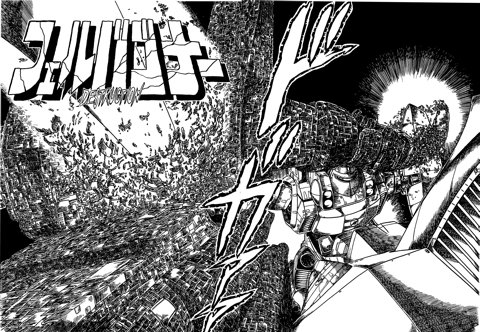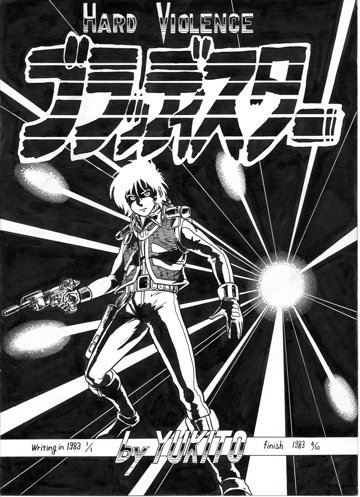The Formal Style Comics Era (1)
"Bloody Star"
1982-1983
"The formal style comics" are completed drafts that were inked and finished on B4 size paper suited for contribution.
On December 20, when my first high school year almost ended, I managed to complete Felbagoner, the first work as a formal style comics.
However, it was meant the first episode for very long piece and was only 10-page work...

Felbagoner episode 1. It was influenced by the original version of Nausika.
Still having a childish mood those days, I was fickle anyhow.
To finish a 10-page completed draft, using with an inexperienced dip pen, was quite an achievement for me of those days, but I couldn't continue the rest of the story. In the beginning I was crazy about creating, but soon got bored.
Before taking a pen, I was excited in plotting a story, which then seemed to me to be stale instantly.
If I hit on a more interesting story, I couldn't continue it any more... As expected, Felbagoner that I began based on the grand plot stopped there, without seeing completion of the second episode.
And it was the next New Year's Day, January 1st, 1983. I changed my mind and began creating a new work.
The title is Bloody Star, which I spent 4 months, till April 10, and completed the 77-page work.

The title page of Bloody Star. Cobra influenced some, such as the way of drawing light.
This was an epoch-making work in various meanings for me in those days.
First, there was great progress in respect of technique. I mastered certain tools, such as dip pens, triangles and curved rules.
Besides, it became great confidence for me to finish a 77-page work.
And the biggest turning point was the story structure.
Here is the outline of Bloody Star.
******
The story happens at Bird City, a small autonomous city with the spaceport as a core on the planet of wilderness.
The stowaway boy Alfas is discovered and shoots a guard, then runs into a slum. Alfas is set prize and the armed motorcycle gang that dominates the slum runs after him, but the boy counterattacks with fighting skill of far exceeding expectation.
The top men of Bird City get information that the boy is not just a stowaway, but also a deserter who had the special training by the Empire. Fearing the Empire's intervention, the top commits rangers and tries to annihilate him together with the motorcycle gang.
Alfas, the motorcycle gang and the ranger go into a three-cornered battle, and the situation reaches to an extreme of confusion.
Finally Alfas comes to shoot down indiscriminately the spacecrafts that are taking-off and landing at the spaceport, then Bird City is covered with flames and destroyed completely.
The motorcycle gang's female vice-leader Griffina survives persistently, and brings herself to a single combat with Alfas.
Alfas shoots her to death and vanishes in wilderness.
The last scene, in the battleship of the Empire on the planetary orbit. It becomes clear that everything was conspiracy to test the combat efficiency of Alfas.
******
The plot is like First Blood or Armored Trooper VOTOMS, but those days VOTOMS didn't start yet and I didn't watch First Blood when I began drawing, so I didn't steel from them...
Before then, the stories I created couldn't escape from some childlike poetic justice and good-and-evil dualism. There always were characters that tell a fair argument. Harder I tried to create serious work, closer it came whitewashing stuff like "the youth's opinion," which I wasn't satisfied with and was impatient to know how I should do better.
But I broke through such immature with this Bloody Star.
No good persons enter in this story. All the characters act by their own interest.
The leading character boy is chased solitarily and becomes a target of assassination without opportunity to excuse, which might engage readers' sympathy for a moment, but he kills people one after another whomever he recognized as an enemy. He doesn't speak much, and there is no psychological depiction, either. He doesn't worry, and there are no flashback scenes. To allow readers to empathize with him wasn't my intention.
They would rather empathize with Griffina, the female vice-president of the motorcycle gang.
Probably she is the most sympathizable character, as her fellows were killed, her darling leader was killed and she pursues Alfas with full of hatred.
However, the heroine is also killed at the end.
In this story, all the characters except the main character and the last wirepuller die.
However, the main character survives. He destroys a whole city and murders all residents there, but still survives.
As a story structure, this is an important point.
Till then, it was common sense of story structures for me that if a character commits a lot of sins like this, of course he must die to atone them at the end.
However, he survives. He does not repent, but kills all of the others and survives.
What does it mean as a story?
There is some important meaning here. Therefore, I was absorbed in drawing this work.
However, I couldn't express what its meaning was in those days.
It was just like Alfas who hardly talked.
After this, every several years I drew such works of serious and dark style that you could say "shout of unconscious karma."
I have labeled the lineage of these works as "Bloody Star thing" and the style would be followed by The Star of Kaiyo, The Rainmaker and the Zapan episodes of GUNNM.
